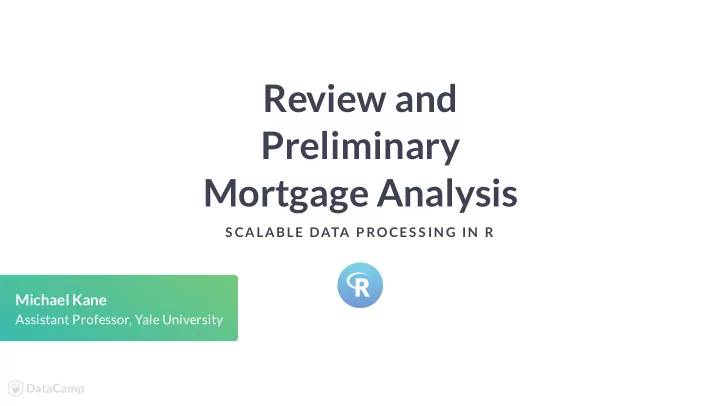

Review and Preliminary Mortgage Analysis S CALABLE DATA P ROCES S IN G IN R Michael Kane Assistant Professor, Yale University
Overview of the chapter Compare proportions of people receiving mortgages Missingness in the data Changes in Mortgage demographic proportions over time City vs rural mortgages Proportion of people securing federally guaranteed loans SCALABLE DATA PROCESSING IN R
United States Census Bureau Race and Ethnic Proportions Category Percentge American Indian or Alaska Native 0.9 Asian 4.8 Black or African American 12.6 Native Hawaiian or Other Paci�c Islander 0.2 Two or more races (Not included) 2.9 Other race (Not included) 6.2 SCALABLE DATA PROCESSING IN R
Proportional Borrowing We know that most mortgages went to people who identify as white. Is this group borrowing more proportionally? SCALABLE DATA PROCESSING IN R
Let's practice! S CALABLE DATA P ROCES S IN G IN R
Are the data missing at random? S CALABLE DATA P ROCES S IN G IN R Michael Kane Assistant Professor, Yale University
SCALABLE DATA PROCESSING IN R
Types of Missing Data Missing Completely at Random (MCAR) Missing at Random (MAR) Missing Not at Random (MNAR) SCALABLE DATA PROCESSING IN R
MCAR Missing Completely at Random There is no way to predict which values are missing Can drop missing data SCALABLE DATA PROCESSING IN R
MAR Missing at Random Missingness is dependent on variables in the data set Use multiple imputation to predict what missing values could be SCALABLE DATA PROCESSING IN R
MNAR Missing Not at Random Not MCAR or MAR Deterministic relationship between variables SCALABLE DATA PROCESSING IN R
Dealing with missing data in this course Full treatment of missingness is beyond the scope of this course We will check to see if it's plausible data are MCAR and drop missing values SCALABLE DATA PROCESSING IN R
A Quick Check for MAR Recode a column with one if the data is missing and zero otherwise Regress other variables onto it using a logistic regression Signi�cant p-value indicates MAR Repeat for other columns with missingness Some p-values can be signi�cant by chance, so adjust your cutoff for signi�cance based on the number of regressions SCALABLE DATA PROCESSING IN R
MAR Quick Check Example # Our dependent variable is_missing <- rbinom(1000, 1, 0.5) # Our independent variables data_matrix <- matrix(rnorm(1000*10), nrow = 1000, ncol = 10) # A vector of p-values we'll fill in p_vals <- rep(NA, ncol(data_matrix)) SCALABLE DATA PROCESSING IN R
MAR Quick Check Example # Perform logistic regression for (j in 1:ncol(data_matrix)) { s <- summary(glm(is_missing ~ data_matrix[, j]), family = binomial) p_vals[j] <- s$coefficients[2, 4] } # Show the p-values p_vals 0.5930082 0.7822695 0.7560343 0.3689330 0.8757048 0.8812320 0.8281008 0.4888898 0.4781299 0.5655739 SCALABLE DATA PROCESSING IN R
Let's practice! S CALABLE DATA P ROCES S IN G IN R
Analyzing the Housing Data S CALABLE DATA P ROCES S IN G IN R Simon Urbanek Member of R-Core, Lead Inventive Scientist, AT&T Labs Research
So far .. Compare different demographic groups in data Quick check to see if data are missing at random SCALABLE DATA PROCESSING IN R
Adjusted Counts and Proportional Change by Year Adjusting group size lets you compare different groups as if they were the same size Proportional change shows growth (or decline) of a group SCALABLE DATA PROCESSING IN R
Let's practice! S CALABLE DATA P ROCES S IN G IN R
Other Lending Trends S CALABLE DATA P ROCES S IN G IN R Simon Urbanek Member of R-Core, Lead Inventive Scientist, AT&T Labs Research
In this lesson ... City vs rural Federally guaranteed loans vs. income SCALABLE DATA PROCESSING IN R
City vs. Rural City means a home is in a metropolitan area, otherwise rural In the mortgage data set, city has msa value of 1, 0 otherwise For a more precise de�nition see FHFA website SCALABLE DATA PROCESSING IN R
Federally Guaranteed Loans and Borrower Income Federally guaranteed loans protect the company issuing a loan If a lender can issue a federally guaranteed loan, then the lender is less worried about the loan defaulting as the government will buy the loan We'll use Borrower Income Ratio: borrower income divided by median income of people in the area SCALABLE DATA PROCESSING IN R
Let's practice! S CALABLE DATA P ROCES S IN G IN R
Congratulations! S CALABLE DATA P ROCES S IN G IN R Michael J. Kane and Simon Urbanek Instructors, DataCamp
Split-Apply-Combine Break the data into parts Compute on the parts Combine the results SCALABLE DATA PROCESSING IN R
Split-Apply-Combine: Advantages Manageable parts don't overwhelm your computer Approach is easy to parallelize Process sequentially Process on serveral machines in a cluster SCALABLE DATA PROCESSING IN R
Split-Apply-Combine: R split() partitions set of row numbers or data.frame Map() computes on parts Reduce() combines results SCALABLE DATA PROCESSING IN R
bigmemory bigmemory Good for larger data sets that can be represented as dense matrices and might be too big for RAM Looks like a regular R matrix SCALABLE DATA PROCESSING IN R
iotools iotools Good for much larger data that can be processed in sequential chunks Supports data.frame and matrix SCALABLE DATA PROCESSING IN R
SCALABLE DATA PROCESSING IN R
Good luck! S CALABLE DATA P ROCES S IN G IN R
Recommend
More recommend